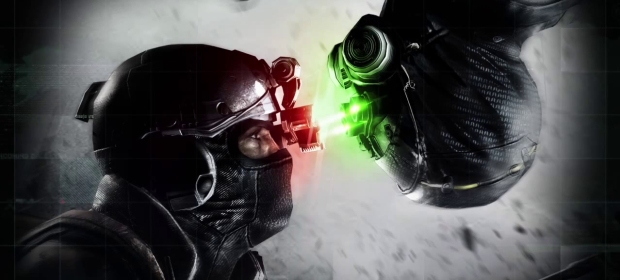I’m not much of a multiplayer gamer, really. I don’t have that competitive edge, that need to win, that constant urge to teabag the prone corpse of my latest victim. Historically I tend to go for games that offer single player value, RPGs and open-world action games, shooters with meaty campaigns and decent AI, stealth titles; you get the idea.
Naturally, being a fan of the stealthy approach, Splinter Cell Blacklist was one of my most hotly anticipated releases this year. I’m a huge fan of Conviction, and I adore the series. I like the choice it gives you, the freedom to go in guns blazing and grenade-hurling, or softly-softly catchy-terrorist. As with most modern iterations of classic franchises, Blacklist makes changes in attempt to increase the depth and scope – and mostly it succeeds. It adds customisation, a black market system to purchase gear and upgrades, side missions, player choice. It’s not “pure” Splinter Cell any more; it’s muddied, shadowed, some would say “evolved”. Perhaps just as many would say “sullied”.
But my focus here isn’t the campaign (as awesome as it is), but the multiplayer aspect, another element of Blacklist that borrows bits and pieces from the previous games but essentially rewrites its own rulebook. The online component of Splinter Cell Blacklist is excellent – let’s get that out of the way right now. The competitive element is far removed from the usual running and gunning PvP seen in action games – it’s tactical, clever and bloody edgy – and the co-op mode is well thought-out, well-designed and genuinely great to play. I would even go as far as saying that in a year that has seen Gears of War: Judgment, The Last of Us, Tomb Raider, Crysis 3, God of War: Ascension and Dead Space 3 all rock their own unique versus modes, Splinter Cell: Blacklist tops the chart. Bold words? Maybe. Inaccurate? Not a bit of it.
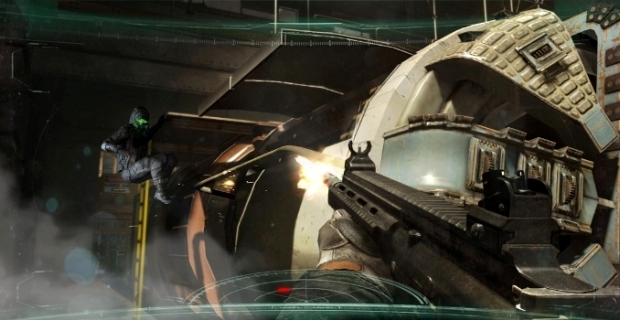
Firstly, there’s the competitive mode, Spies vs. Mercs, in which Blacklist dumps Conviction’s largely hit and miss online component in favour of a return to a more traditional method of team-based mass-murder.
First seen way back in Splinter Cell: Pandora Tomorrow (game number 2 in the series), Spies vs. Mercs was a much simpler affair, where two players decked out as shadow-hugging spies snuck around a claustrophobic map while a pair of heavily-armed mercenaries hunted them down. In true Splinter Cell style, light and shadow played a pivotal role, the spies with their night-vision and the mercs with their torches. In Blacklist, the mode makes a welcome return, but with a handful of changes and improvements that make SvM a truly essential part of the package.
Obviously, Sam moves differently now, given that modern games never stick to running around on the ground when they can send you up buildings or down zip-lines willy-nilly. While you don’t play as Sam in SvM, the mechanics remain identical, and so Ubisoft were able to make the evolved Spies vs. Mercs more vertical, more intricate, and thus more tactical. Every mode centres around three computer terminals that must be hacked by the Spies and defended by the Mercs.
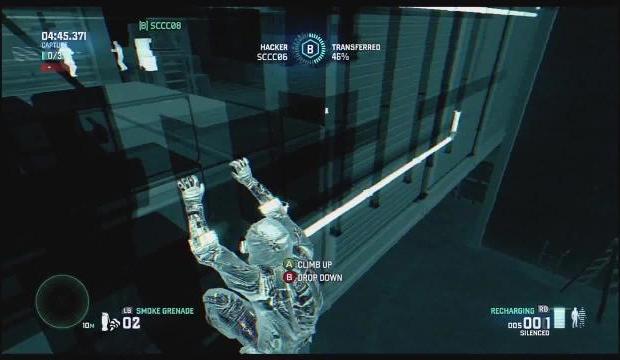
A typical game will see a Spy find and hack a terminal by holding down the Y (or Triangle) button, then bolt for cover as the area fills with armour-clad Mercenaries. The goal for the Spies is to survive until the hack is complete, while the Mercenaries have to kill the Spy that started the hack in order to stop it. The whole affair is unbelievably tense, as the Spies stick to the darkness and dispatch their hunters with one-button instant stealth kills and the torch-wielding Mercenaries can hurl grenades or riddle their quarry with bullets in mere seconds.
This is not Call of Duty, or Halo, or Battlefield – this is Splinter Cell. Encounters don’t degenerate into prolonged firefights or frag-matches. Usually, whoever gets seen first is dead. Playing as a Mercenary seems tougher, navigating the dark maps in first-person with a flashlight and a perpetually itchy trigger finger. Now and then the motion tracker will beep, flashing once with the direction of movement to announce that a Spy is in close proximity. In that instant it’s easy to forget that the danger isn’t real, that that the Spy is just another gamer like you. The instant kill that often follows is enough to make you physically jump. It evokes more than just Splinter Cell, which is of course the beauty of it. You’re suddenly feeling as on-edge and adrenalized as you would be playing a survival horror game. It’s a bug-hunt, Aliens-style, as you seek out the danger in the darkness.
On the flip-side, the Spies don’t get an easy ride either. Utilising the classic Splinter Cell 3rd-Person PoV, the spies can mantle onto higher platforms, hang from ledges, perform drop assassinations and move silently. In certain modes an infrared camera can highlight the location of advancing Mercenaries. But the trick is getting behind them. Try to take a Merc out face to face and you’ll be chewing on bullets in seconds. Find yourself out in the open and you will feel like a rabbit in the headlights. Eight times out of ten, you will get mowed down, too.
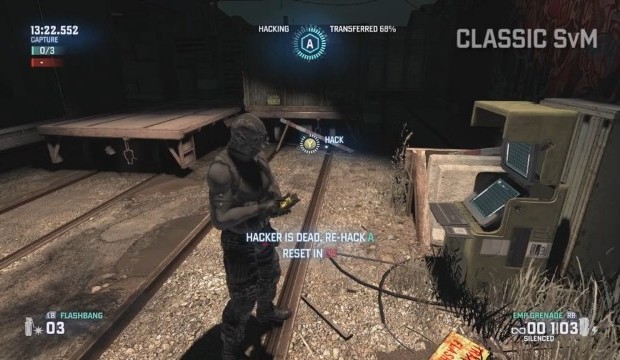
Outside of “Classic” mode (which removes avatar customisation and has you rely purely on night vision and flashlights), SvM is more customizable, allowing you to alter your tactics and experiment with weapon loadouts until you find a play-style that suits. There are several to unlock, which you do with currency earned in either multiplayer or the campaign, and each has specific uses. The Spies can equip themselves with stun crossbows and EMP mines to counteract the Mercenaries’ scanners, while the Mercs can employ proximity mines to booby-trap terminals or unlock a device to dampen the infrared vision of the Spies.
The only way to ensure success is to work together. Voice chat is a great advantage, but can ruin the claustrophobic ambience. There’s no substitute for simply covering each other’s backs as the Spies, especially in the larger 4v4 games. Watch the entryways and stick to the shadows, and holding out for 90 seconds becomes that little bit more attainable. With the Mercs the onus is on teamwork to avoid a sneaky backstab, and forming a unit to corner the Spies and force them to either move out of desperation or wait impotently until you splatter them. There’s more depth to it than that, of course, and the loadouts allow for a great deal of tactical freedom. A few more objective-based modes would be welcome, but as a multiplayer experience Spies vs. Mercs is unique and hugely playable.
There are several other modes besides standard SvM, such as Extraction, which plays similarly but with the roles reversed so that the Mercs are trying to steal data and the Spies are trying to stop them. The core concept is the same, while “Uplink” plays like a modified version of Black Ops II’s Hardpoint. There’s even a Team Deathmatch if you fancy some good old-fashioned killing without all the objectives getting in the way. It’s all unlocked at Rank 5, so you’ll need to spend a little time in the Training Grounds before you can start – which you’ll need to do anyway if you’re new to the concept. It’s a robust roster of modes and offers something for every taste, but all tinged with Splinter Cell’s unique flavour.
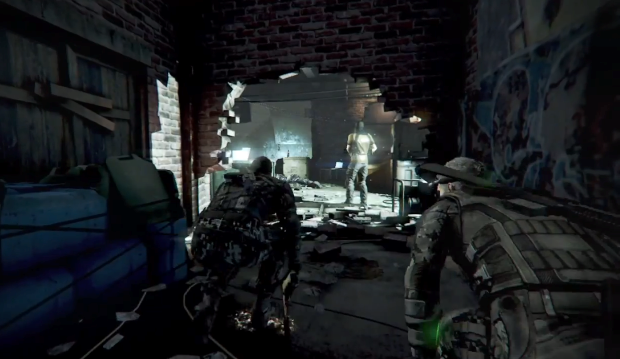
The other multiplayer mode is the integrated co-op mode. In Conviction there was a separate co-op campaign featuring the shadowy exploits of Kestrel and Archer, but in Blacklist the action stays firmly with Fisher.
While navigating the 4th Echelon mobile headquarters (onboard a bloody big jet), you can talk to your team members about various side ops, and several of these are either playable in solo or co-op, or co-op only. Tackling a co-op map can be done in split-screen, or across the ‘net with a friend or a stranger, and the middle option is certainly the best. While couch co-op is always fun, split-screen is restrictive in a game where you really need your entire field of vision, and playing with strangers is okay in a pinch, but playing with someone you know injects some fun into the silence and violence.
The other player controls Briggs, Fisher’s sniper and recon scout who often accompanies him on campaign missions to provide ranged support and intel on the ground. For the purposes of a balanced game, he’s every bit as capable as Fisher (even if, in actuality, Fisher could kill him twice before breakfast on any given day), and plays almost identically.
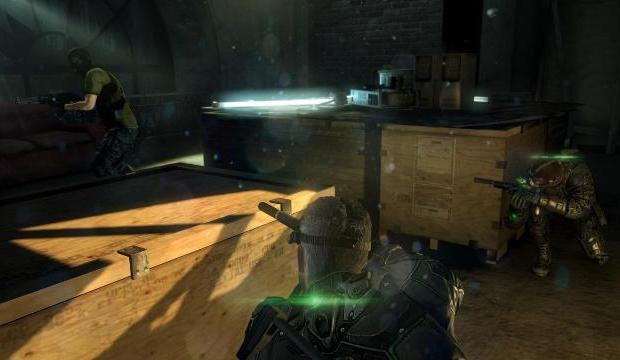
During co-op missions you can access otherwise locked routes and secondary paths through missions by making use of “dual boost” points to reach rooftops and mantle onto high ledges. You’ve often got the option of having a man on the ground while the other provides cover, and voice chat makes it all incredibly immersive.
Aside the boosting, there’s also a “dual execute” move, where one player can hold down Y or Triangle, and the other player hits the same button to initiate a team takedown – especially useful for removing those big buggers with riot shields and helmets. Levels are designed with co-op in mind, meaning that there’s great scope for being incredibly slick and clever (something I haven’t managed to master yet).
There are issues, but only if you’re not working as a team. Technical glitches aren’t all that common, and mostly involve disappearing corpses or a spot of slowdown (which is more likely due to lag than to the game itself). I should point out that playing in split-screen is not the best option here. Splinter Cell relies so heavily on light and shadow that the action can be hard to fully take in with only half the screen space. You also really need to communicate, so unless you’re particularly garrulous among strangers it’s better played with a friend (which also makes it bloody good fun when things go wrong and you have to improvise).
This mode is custom built for co-op. It’s not just a case of dropping in and out and increasing the number of baddies. It’s about teamwork and communication, observation and patience. A well-oiled partnership can dominate in some of the missions and, alongside Spies vs. Mercs, it’s another reason why Splinter Cell: Blacklist is rocking the most interesting and compelling multiplayer package of the year so far.


